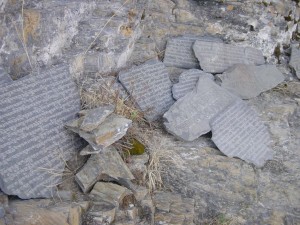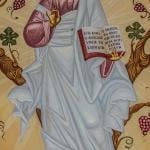 The tablets were God’s work, and the writing was God’s writing, incised upon the tablets. —Exodus 32:16
The tablets were God’s work, and the writing was God’s writing, incised upon the tablets. —Exodus 32:16
And the Lord gave me the two tablets of stone inscribed by the finger of God, with the exact words that the Lord had addressed to you on the mountain out of the fire on the day of the Assembly. —Deuteronomy 9:10
Thereupon the Lord said to me, “Carve out two tablets of stone like the first, and come up to Me on the mountain; and make an ark of wood. I will inscribe on the tablets the commandments that were on the first tablets that you smashed, and you shall deposit them in the ark.” —Deuteronomy 10:1 – 2
God hewed the first set of tablets and wrote directly on them. Moses carved the second set, and then God, with God’s finger, inscribed the exact words that God said “on the mountain out of the fire on the day of the Assembly.”
A replacement, a duplicate, though not exactly, from original to replica, from presence, flashing and fleeting, to preservation. From “from” to “to” and the distance between.
The rabbis know distance well, an obstacle blocking our way back (to Sinai, to revelation). They also know the reaction to such an obstacle: intense longing to get back to where we once belonged, even though we know we can’t.
This summer I listened to Joni Mitchell’s Ladies of the Canyon on my Prius’s sound system into which my smartphone is plugged. The past plugged into the present.
Joni Mitchell (Ladies and Blue), Tim Buckley (Happy Sad), Randy Newman (12 Songs), and Neil Young (After the Gold Rush) are the perfect diet for adolescent loneliness and longing. So why am I listening to them in late-middle age? Am I trying to get back to the early hours of looking for love (romantic, sexual, spiritual: I couldn’t distinguish among them then)?
Imagination, not music, not memory, and certainly not anti-depressants, is what the rabbis prescribe to cure homesickness for the past. They command me to use imagination to transport myself all the way back to Mt. Sinai where God is speaking, right now, to the more than one million (counting women and children) freed slaves.
I obey. I am transported. I tremble in awe at the foot of Sinai among this, my people. I hear the exact words. This morning.
This morning I sit quietly at my desk, more than 6,000 miles from Sinai, more than 3,000 years after the revelation. I hear muffled Spanish-speaking voices, painters working outside the study in which I try to concentrate on the voice (my voice? but if not mine, whose?) revealing, haltingly, word by word this meditation on the phrase “two tablets of stone like the first.”
The shattered pieces of the original tablets, the first draft, are gone now.
How sad, for had the tablets survived, the rabbis write, “every sorrow and calamity would have disappeared from the earth, and the world would have experienced freedom from the Angel of Death.”
So the rabbis imagine, so their story comes down to me through the work of the great anthologist of Jewish legend and lore, Howard Schwartz.
The second set of tablets, the revised work, that’s all we get to carry home.
Creation, destruction, revision: the creative process, a process the Torah represents again and again.
For instance, Eden is a perfect place to begin, until it isn’t. Take it away and begin again east of Eden. The generations leading from Adam to Noah: a great story of an unrighteous people—until it isn’t. Taken away by flood, the great erasure. Begin again.
Jacob? He doesn’t become our namesake until he’s wounded (revised). Then, only then, does he become Israel. Joseph? A father’s favorite, a spoiled son . . . until he’s buried and rises from the grave into his new (revised) identity, Vizier of Egypt, the only one with the power to save his family, his people from vanishing.
First thought best thought? Nope. Revise, revise, revise, the Torah tells us, chapter after chapter, verse after verse.
Yet, it knows us deeply and well, we who seek, who insist on, who will settle for nothing less than the original. Hadeish yameinu k’kedem, renew our days as before, we sing to the Torah scroll, now returned to the ark after the public chanting has concluded, moments before the ark is closed.
How we try to hold onto, preserve, fix permanently in place, some place, what came first, as if it were sacred.
We look at each other now, my first love and I, from a distance of thirty-six years, through the lens of an occasional e-mail, text, phone call. In my life, she is the author of Eat a Peach (The Allman Brothers) and The Revolution Will Not Be Televised (Gil Scott-Heron).
Did she break me? Did I break her? Do we imagine returning to the hour before the shattering? Hadeish yameniu k’kedem: renew our days. Is that the fantasy, my fantasy, hers, as our days recede further into the past?
I have revised my life, and it is good, very good.
The Torah knows, deeply and well, our nostalgia for home and the past. It gives it to us, repeatedly. And it takes it away from us, time and time again.
The authors of Torah do everything they can to model Torah as process, not product. Do not cling to it, they warn us, do not hold fast to every letter, in the exact order, in which it was originally revealed.
That’s the challenge, the steep challenge posed to us by Torah: To receive it and make something new of it. Even if that requires an action as bold as Moses’s.
Smashing it.










